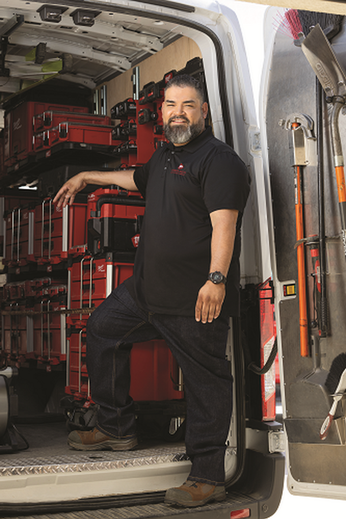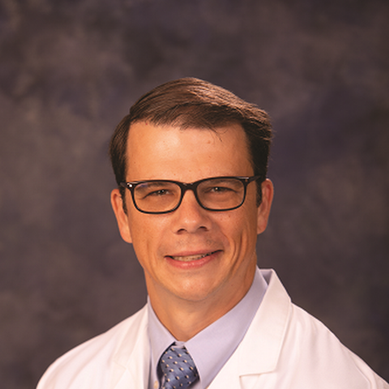Hand in Hand

Espinoza’s screams drew his grandparents, who managed to free his arm, pack it in ice and rush him to a local doctor. Espinoza’s hand was sore, bruised and weaker than his left, but it seemed to heal at first.
However, a problem lurked beneath the surface — life-altering damage to his radial nerve. This vital nerve, which runs down the back of the arm from the armpit to the hand, is responsible for sensation and movement in the arm, elbow, wrist and hand.
At school in California, Espinoza taught himself to be ambidextrous. By the time he reached high school, his difficulties mushroomed. “My hand had changed,” says Espinoza, now 41. “I had less and less function.”
A bad problem worsens
Eventually, Espinoza’s wrist flexed downward, and his fingers curved. “I could hold some things, like a barbell, but I couldn’t keep a glass of water upright,” he says. “Depending on my hand’s position, I would lose complete control.”
By the time he met Jacob Bosley, MD, Board Certified in Orthopedic Surgery, at Eisenhower Desert Orthopedic Center (EDOC) in 2021, Espinoza owned a thriving business creating fully connected homes for his clients, including TV and cable, surround sound, Wi-Fi and security systems.
What he couldn’t do, he says, “was give you a high five or a thumb’s up.” He also couldn’t shake a client’s hand with his right hand.
“Our hands are one of the main ways we interact with the world,” says Dr. Bosley. “A handshake has a lot of value and meaning, especially for an entrepreneur like Maui.”
Espinoza had consulted with several surgeons over the years about correcting his hand. They all turned him down. His injuries were too old, they said, the muscles and nerves dormant.

Espinoza then consulted with Dr. Bosley, who outlined an option he hadn’t heard of — tendon transfer surgery — which would replace non-working tendons in his wrist and hand with working ones, giving him the ability to power his wrist, hand and fingers again. “I was ready to do it,” he says. “If it could be fixed, I wanted my hand.”
In medical school, Dr. Bosley developed an interest in traumatic injuries and intricacies of the hand, wrist, elbow and shoulder. He went on to become fellowship trained in hand and upper extremity surgery. “What drew me to hand surgery was how intricate and delicate it is,” he says. “I especially enjoy helping to restore function in someone’s hand.”
Many injuries to the radial nerve heal themselves. “Recovery must take place within 18 months for the signal from the nerve to return and link with the muscle,” says Dr. Bosley. “If not, you lose the connection.”
Tendons are the strong, fibrous cords that connect the muscle to the bone. Physicians in the late 19th century discovered that transferring tendons could restore function to an extremity.
The most significant recent advance isn’t in surgical technique but in the ability to keep appropriate patients partially awake during surgery. By using light anesthesia, the surgeon can give the patient instructions on the operating table to move a wrist or flex the fingers — “so we can see the replacement tendon work before finalizing it,” says Dr. Bosley. Light anesthesia isn’t for everyone; because of other health concerns, Espinoza received full anesthesia.
A change on its way
To determine which tendons to transplant, Dr. Bosley looks for one that is expendable or in duplication. “Something that can be taken away without any significant loss,” he says.
In February 2022, Espinoza underwent tendon transfer surgery. Dr. Bosley selected three tendons from the palm side of the forearm and transferred them to the back of the hand and wrist. In doing so, he restored Espinoza’s ability to power extension of his thumb, fingers, and wrist.
Espinoza wore a cast for more than a month to allow his hand to heal in the desired position. Soon after, he started therapy at EDOC, honing his fine motor skills by handling various objects with his newly extended fingers. “I started realizing how much I could do that I couldn’t do before,” he explains.
“Maui’s success is the result of teamwork between a surgeon, anesthesiologist, occupational therapist and the patient, putting in the work himself,” says Dr. Bosley.
At a follow-up visit, Espinoza used his right hand to shake the hand of the surgeon who made it possible. “After being told ‘No’ so many times,” says Espinoza, “Dr. Bosley gave me a chance.”
For more information or to contact Eisenhower Desert Orthopedic Center, call 760.568.2684, or visit EisenhowerHealth.org/EDOC.



